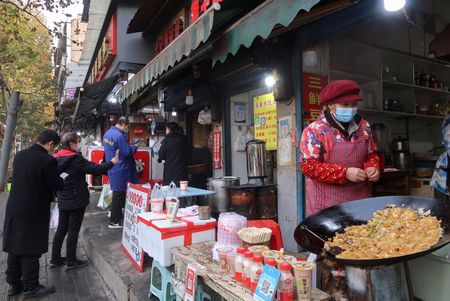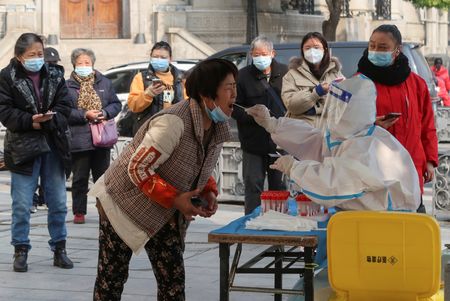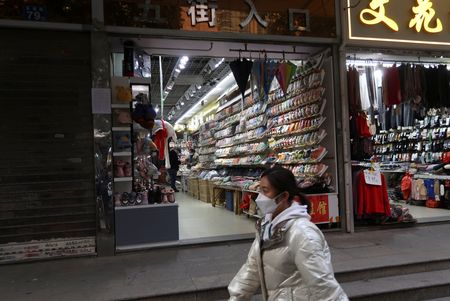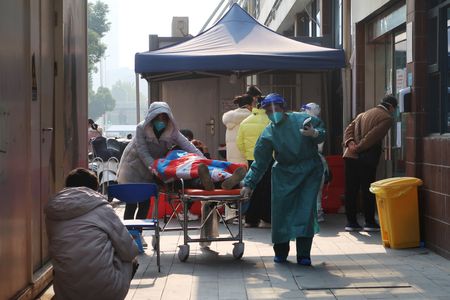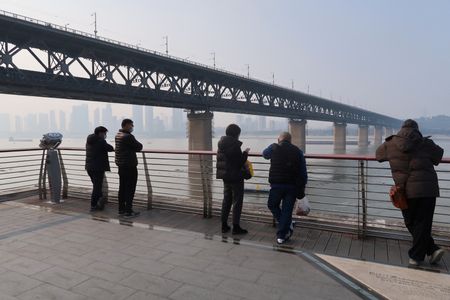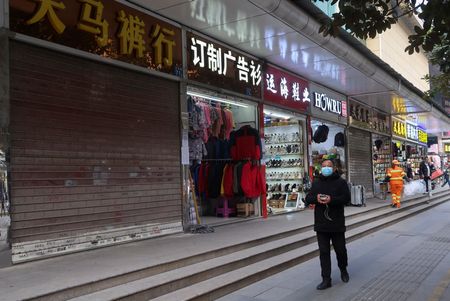By Martin Quin Pollard
WUHAN, China (Reuters) – Infections are delivering a fresh kick in the teeth for many small businesses in China’s central city of Wuhan, despite the easing of most stringent curbs last week.
With the sick and those fearing infection keeping to their homes, hopes of brighter prospects after the end of lockdowns are evaporating, at least for now, with the government showing few signs of stepping in to help.
“I simply can’t go on,” said Zhu Chongping, 60, as he looked around his empty restaurant, which dishes up regional cuisine in the city of more than 13 million where the COVID-19 pandemic began three years ago.
“I’m losing money every day, a thousand yuan a day.”
The challenge for small businessmen like Zhu spotlights how Beijing’s shift away from tough COVID policies, with the promise of driving an economic recovery next year, is likely instead to depress growth over the next few months as infections surge.
Business on what would normally be a buzzing food street, where most restaurants were shut or empty last Saturday, is the worst it has been since Zhu first opened his doors to customers 30 years ago, he added, looking forlorn.
The outlook after “zero-COVID” eased, following unprecedented protests, is even bleaker than during the city’s 76-day lockdown in 2020, he said, because this year his landlord is not offering a discount on his rent.
Rent subsidies and consumer vouchers had been among the measures local authorities rolled out to support business at that time, but there are few such signs this year.
“This street is considered a top location in Wuhan,” Zhu added. “Now there is no one about. You can imagine that other locations are even worse.”
The only queue within several hundred metres was outside a pharmacy, where people waited to stock up on medicines to treat the symptoms of COVID.
“My business is struggling to stay afloat,” said the owner of a bag store on nearby Hanzheng Street, home to one of China’s biggest wholesale clothing markets and the site of a large anti-lockdown protest last month.
“We have to see what happens next year … ,” added the 48-year-old, surnamed Liang. “We have to see what the footfall will be like. If things are still the same next year, vendors will have to leave.”
Many other shopkeepers simply told Reuters they had zero or “no business”.
Sunday’s 153 infections were down from 217 the previous day, government data showed, in a growing nationwide trend after China all but gave up encouraging or demanding regular testing.
The scarcity of customers is having a knock-on effect on other industries, further hurting growth as China grapples with an economic downturn this year.
“There are not many new stores opening and not many new businesses starting, so our business cannot get going and we are facing layoffs,” said Huang, the owner of an advertising business who asked to be identified only by his surname.
People just do not have much money anymore, said a Wuhan taxi driver, surnamed Sun, adding that subsidies had made the 2020 lockdown more manageable than this year’s measures.
“With all these lockdowns I’ve earned nothing for weeks,” he said. “Now, it’s a tiny bit better, but I can only make enough to pay back the company my monthly taxi rental fee.”
Surveys have shown factory activity shrank in November amid widespread COVID curbs, while exports and imports fell at their steepest pace in at least 2-1/2 years, piling more pressure on the slowing economy.
Zhiwu Chen, a finance professor at the University of Hong Kong, said he felt authorities hoped the infections would usher in sufficient immunity within three or four months, allowing small and medium -sized businesses to rebound.
“Of course in the process the country will suffer from the shock therapy,” he added.
“I hope they will be able to sustain the shock.”
(Editing by Brenda Goh and Clarence Fernandez)

